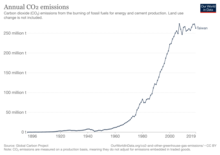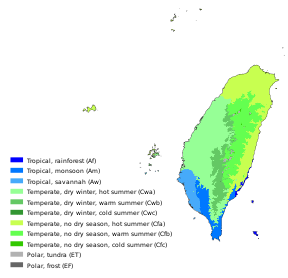Climate change in Taiwan has caused temperatures in Taiwan to rise by 1.4 degrees Celsius the last 100 years. The sea around Taiwan is to rise at twice the rate of the global sea level rise. The government pledged to reduce emissions by 20% in 2030 and 50% in 2050, compared to 2005 levels.
Greenhouse gas emissions

In 2020 the annual CO2 emissions were 273.17mt and 11.47t per capita, since 2005 there have been a stabilisation of CO2 emissions with the annual CO2 emissions increasing with 2.52% and the per capita CO2 emissions decreasing with 2.26% between 2005 and 2020. In 2020 the cumulative CO2 emissions were 9.05 billion tonnes, in 2020 Taiwan was responsible for 0.78% of worldwide emissions. The government of Taiwan has pledged to reduce emissions by 20% in 2030 and 50% in 2050 comparing to 2005 levels. Taichung Power Plant is estimated to have been one of the ten most carbon polluting coal-fired power plants in the world in 2018, at 29.9 million tons of carbon dioxide, and relative emissions are estimated at 1.282 kg per kWh.
Impacts on the natural environment
Temperature and weather changes

 Köppen climate classification map for Taiwan for 1980–2016
Köppen climate classification map for Taiwan for 1980–2016 2071–2100 map under the most intense climate change scenario. Mid-range scenarios are currently considered more likely
2071–2100 map under the most intense climate change scenario. Mid-range scenarios are currently considered more likely
According to the Taiwan Climate Change Projection Information and Adaptation Knowledge Platform (TCCIP) the number of days that record above 36 degree Celsius in the plains of Taiwan can go from less than 1 day a year in 2021 to 48.1 days in 2100 if the global temperature rise isn't kept under 1.5 degree Celsius, if it is kept under 1.5 degree Celsius there would be 6.6 days a years with such temperatures. The summers could also be extended by the end of the century from 80 days to 210 days, the winters will become shorter with 0 to 50 days compared to 70 days in 2021. The summer of 2020 has been recorded as having the hottest weather ever in Taiwan.
Sea level rise
In a report that Greenpeace Taiwan published in August 2020, it was reported that the sea around Taiwan is rising at twice the rate of the global sea level rise. They said 6 municipalities are in danger of sea level rise and storm surges which accounts for 70% of the population. Places like the Presidential Office Building in Taipei, Songshan Airport, parts of Kaohsiung would be flooded and Tainan would see the biggest damage due to flooding.
Ecosystems

Coral reefs in Taiwan have experienced bleaching with 2020 experiencing the worst bleaching in 22 years. 31% of coral reefs around Taiwan are dying due to high temperatures in the sea water. 52% of the corals is experiencing different levels of heat stress and 31% is dying in an irreversible process.
Water resources
Shortages in water reservoirs have been announced in 2020 caused by typhoons not making landfall on Taiwan or going near Taiwan this was the first year in more than 50 years that Taiwan didn't see a storm. Typhoons would normally make landfall three to four times a year but since 2010 the average has been 2.5 typhoons a year. 2020 has experienced the worst drought in more than 50 years as rainfall declined with 20% to 60%.
Northern Taiwan could experience more frequent spring droughts between 2040 and 2060, which could have an effect on the water use for the public and water use for agriculture. At the end of the century typhoons that make landfall in Taiwan will decrease between 44% and 54% comparing to typhoons that made landfall between 1974 and 2015. Which would lead to stronger winds by 4% to 8% and more rainfall during the typhoon with 30% to 40%, the rainfall annually would drop with 40% to 60%.
Mitigation and adaptation
Policies and legislation
The Taiwanese government has pledged to increase renewable energy usage to 20% by 2025. The government pledged to reduce emissions by 20% in 2030 and 50% in 2050, compared to 2005 levels, which was signed to by the 2015 Taiwan Greenhouse Gas Reduction and Management Act. This would not be enough to keep global temperatures between 1.5 and 2 degrees Celsius, according to the RSPRC. The government of Taiwan has invested in the wind turbine industry, Taiwan had the 8th biggest offshore wind market in the world in 2019.
Pricing of carbon
Taiwan does not currently have any form of carbon tax. In 2009, the Chung-Hua Institution for Economic Research (CIER), which had been commissioned by the government to advise on its plan to overhaul the nation's taxes, recommended a levy of NT$2,000 (US$61.8, £37.6) per tonne of CO2 emissions. As a result, vice finance minister Chang Sheng-ho announced a plan for a carbon tax in starting 2011, with the revenues funding low-income families and public transport. However, Premier Wu Den-yih opposed implementing the tax, arguing it would increase public suffering during the then ongoing recession. The carbon tax was never implemented.
As opposed to the commonly adopted carbon tax, Taiwan's Climate Change Response Act has proposed implementation of a carbon fee. This would require local companies emitting more than 25,000 tonnes of carbon per year to pay a fee. The carbon fee would come into effect from 2024 or 2025 and would start with large emitters, while other carbon emitting groups would be added subsequently after the initial law is passed.
Society and culture
Public perception
According to a survey that the RSPRC conducted in April 2020, 85% of Taiwanese said that they experienced the effects of climate change on some level. The survey also found that acceleration of energy transition and reduction in carbon was ranked in third place with 38.7% when asked what the government long terms priorities should be. There is bipartisan support under supporters of the Pan-Blue camp (76.2%) and the Pan-Green camp (84%) for a proactive promotion of an energy transition. 78.5% of the respondents supported the governments targets for 2025 to have 20% of renewable energy in 2025. Respondents gave 3.83 out of 7 points for how fair the energy transition is, they gave 3.74 out of 7 points to how well planned the energy transition is and they gave 4.32 out of 7 points on how urgent the government acted on it. A total of 44.7% are supportive to phase out fossil fuels, 43.7% were against phasing out fossil fuels. Academics and experts were the most trusted when talking about energy information (59.3%), environmental groups came second (37.6%). 59.8% of respondents said that businesses should be required to have obligations with the energy transition if they get stimulus from the government to help them through COVID-19, 77.2% of respondents wanted that they did the same for airlines.
See also
References
- "Climate of Taiwan". Travel Tips - USA Today. Archived from the original on 2021-07-29. Retrieved 2021-08-12.
- ^ "Taiwan faces watery future: Greenpeace - Taipei Times". www.taipeitimes.com. 2020-08-25. Archived from the original on 2020-10-26. Retrieved 2020-12-02.
- Ritchie, Hannah; Roser, Max (2020-05-11). "CO₂ and Greenhouse Gas Emissions". Our World in Data. Archived from the original on 2021-11-02. Retrieved 2021-11-02.
- ^ "Is Taiwan Doing Enough to Address Climate Change in The Hottest Summer Ever?|Politics & Society|2020-08-19|web only". CommonWealth Magazine. Archived from the original on 2021-07-06. Retrieved 2020-11-15.
- Grant, Don; Zelinka, David; Mitova, Stefania (2021). "Reducing CO2 emissions by targeting the world's hyper-polluting power plants". Environmental Research Letters. doi:10.1088/1748-9326/ac13f1. ISSN 1748-9326.
- Hausfather, Zeke; Peters, Glen (29 January 2020). "Emissions – the 'business as usual' story is misleading". Nature. 577 (7792): 618–20. Bibcode:2020Natur.577..618H. doi:10.1038/d41586-020-00177-3. PMID 31996825.
- Schuur, Edward A.G.; Abbott, Benjamin W.; Commane, Roisin; Ernakovich, Jessica; Euskirchen, Eugenie; Hugelius, Gustaf; Grosse, Guido; Jones, Miriam; Koven, Charlie; Leshyk, Victor; Lawrence, David; Loranty, Michael M.; Mauritz, Marguerite; Olefeldt, David; Natali, Susan; Rodenhizer, Heidi; Salmon, Verity; Schädel, Christina; Strauss, Jens; Treat, Claire; Turetsky, Merritt (2022). "Permafrost and Climate Change: Carbon Cycle Feedbacks From the Warming Arctic". Annual Review of Environment and Resources. 47: 343–371. doi:10.1146/annurev-environ-012220-011847.
Medium-range estimates of Arctic carbon emissions could result from moderate climate emission mitigation policies that keep global warming below 3°C (e.g., RCP4.5). This global warming level most closely matches country emissions reduction pledges made for the Paris Climate Agreement...
- Phiddian, Ellen (5 April 2022). "Explainer: IPCC Scenarios". Cosmos. Archived from the original on 20 September 2023. Retrieved 30 September 2023.
"The IPCC doesn't make projections about which of these scenarios is more likely, but other researchers and modellers can. The Australian Academy of Science, for instance, released a report last year stating that our current emissions trajectory had us headed for a 3°C warmer world, roughly in line with the middle scenario. Climate Action Tracker predicts 2.5 to 2.9°C of warming based on current policies and action, with pledges and government agreements taking this to 2.1°C.
- "Climate change may cost Taiwan dearly without action: experts - Focus Taiwan". focustaiwan.tw (in Chinese). Archived from the original on 2021-08-11. Retrieved 2021-08-12.
- "Coral bleaching in Taiwan waters worst in 22 years: Greenpeace - Focus Taiwan". focustaiwan.tw (in Chinese). Archived from the original on 2020-11-16. Retrieved 2020-11-15.
- "One-third of Taiwan's corals dying due to bleaching: researchers - Focus Taiwan". focustaiwan.tw (in Chinese). Archived from the original on 2021-01-12. Retrieved 2021-01-13.
- "Water crisis looms in Taiwan in year of zero typhoons". Taiwan News. Archived from the original on 2020-11-21. Retrieved 2020-11-17.
- "Taiwan may see fewer typhoons but more droughts as climate warms". South China Morning Post. 2020-12-22. Archived from the original on 2020-12-23. Retrieved 2020-12-23.
- "When Flooding, Heatwaves, Droughts Become the Norm in Taiwan|Politics & Society|2019-11-18|CommonWealth Magazine". CommonWealth Magazine. Archived from the original on 2021-07-06. Retrieved 2020-11-15.
- "Typhoons to halve by century's end - Taipei Times". taipeitimes.com. 2020-11-15. Archived from the original on 2020-11-14. Retrieved 2020-11-15.
- ^ "New Survey Shows Strong Support for Energy Transition in Taiwan". rsprc.ntu.edu.tw. Archived from the original on 2020-12-01. Retrieved 2020-12-05.
- ^ Chan, Yvonne (20 October 2009). "Taiwan plans taxes for energy and CO2 emissions by 2011". Businessgreen. Archived from the original on 24 October 2009. Retrieved 5 August 2010.
- "Taiwan plans energy tax starting in 2011". Earth Times. 19 October 2009. Archived from the original on 15 May 2011. Retrieved 5 August 2010.
- Jehng-jung, Kao (26 October 2009). "The carbon tax proposal needs more airtime - Taipei Times". www.taipeitimes.com. Archived from the original on 20 September 2022. Retrieved 19 September 2022.
this decision was instantly rejected by Premier Wu Den-yih (吳敦義)
- "Carbon-reduction will benefit the economy in the long run". Taiwan Today. 31 December 2009. Archived from the original on 20 September 2022. Retrieved 19 September 2022.
Premier Wu Den-yih has also said "the stomach must be taken care of first."
- "Draft bill ignores carbon trading - Taipei Times". www.taipeitimes.com. 6 September 2022. Archived from the original on 4 October 2022. Retrieved 13 April 2023.
It stipulates that local companies emitting more than 25,000 tonnes of carbon per year would be required to pay a carbon fee, rather than the commonly adopted carbon tax.
- "Cabinet approves phased carbon pricing scheme - Taipei Times". www.taipeitimes.com. 22 April 2022. Archived from the original on 29 September 2022. Retrieved 29 September 2022.
As for when the carbon fee would be introduced, Tsai estimated sometime in 2024 or 2025.
| Climate change by country | |
|---|---|
| Greenhouse gas emissions, impacts, mitigation and adaptation in each country | |
| Africa | |
| Americas | |
| Asia | |
| Europe | |
| Oceania | |
| Polar regions | |
| Other regions | |